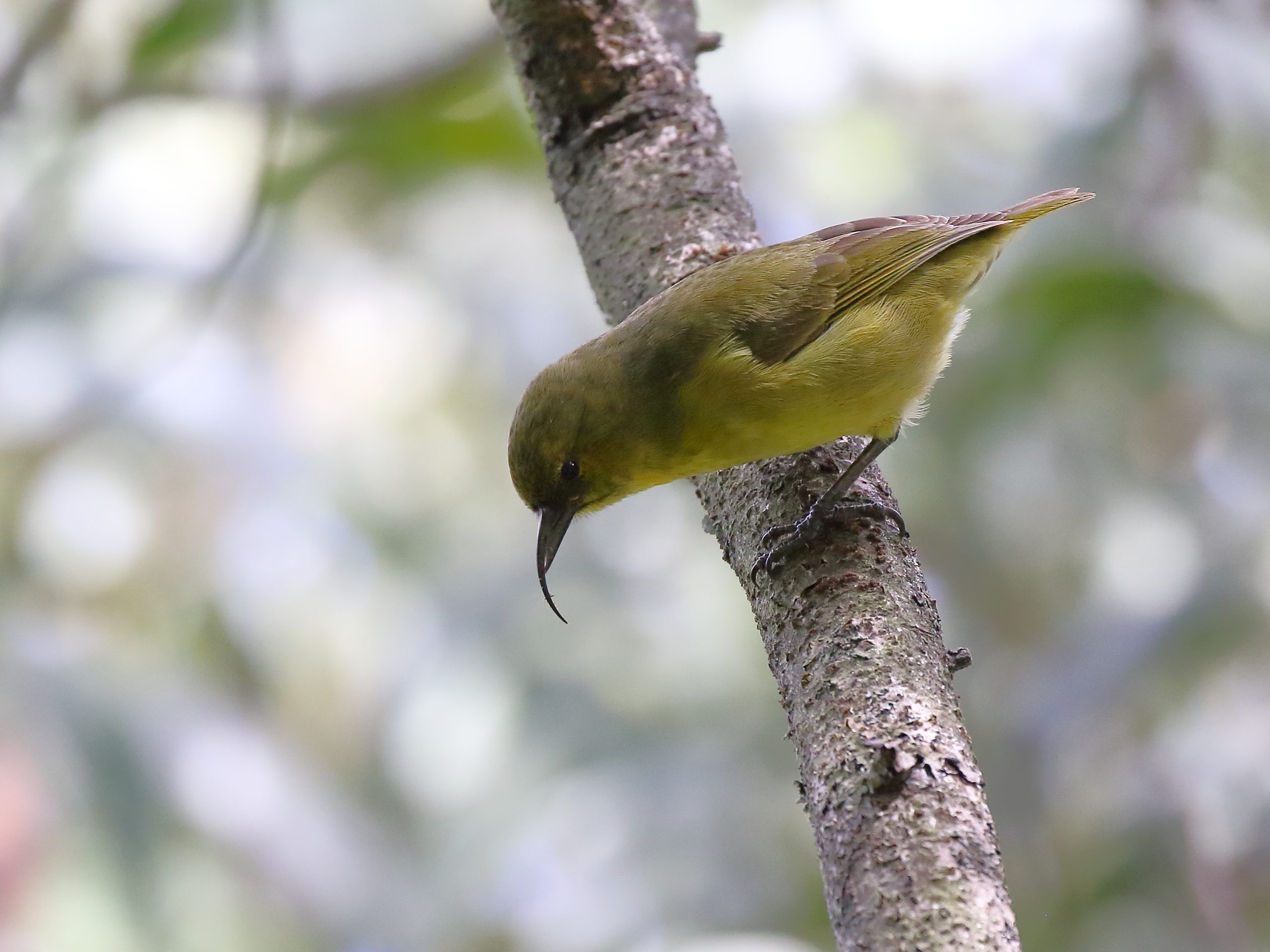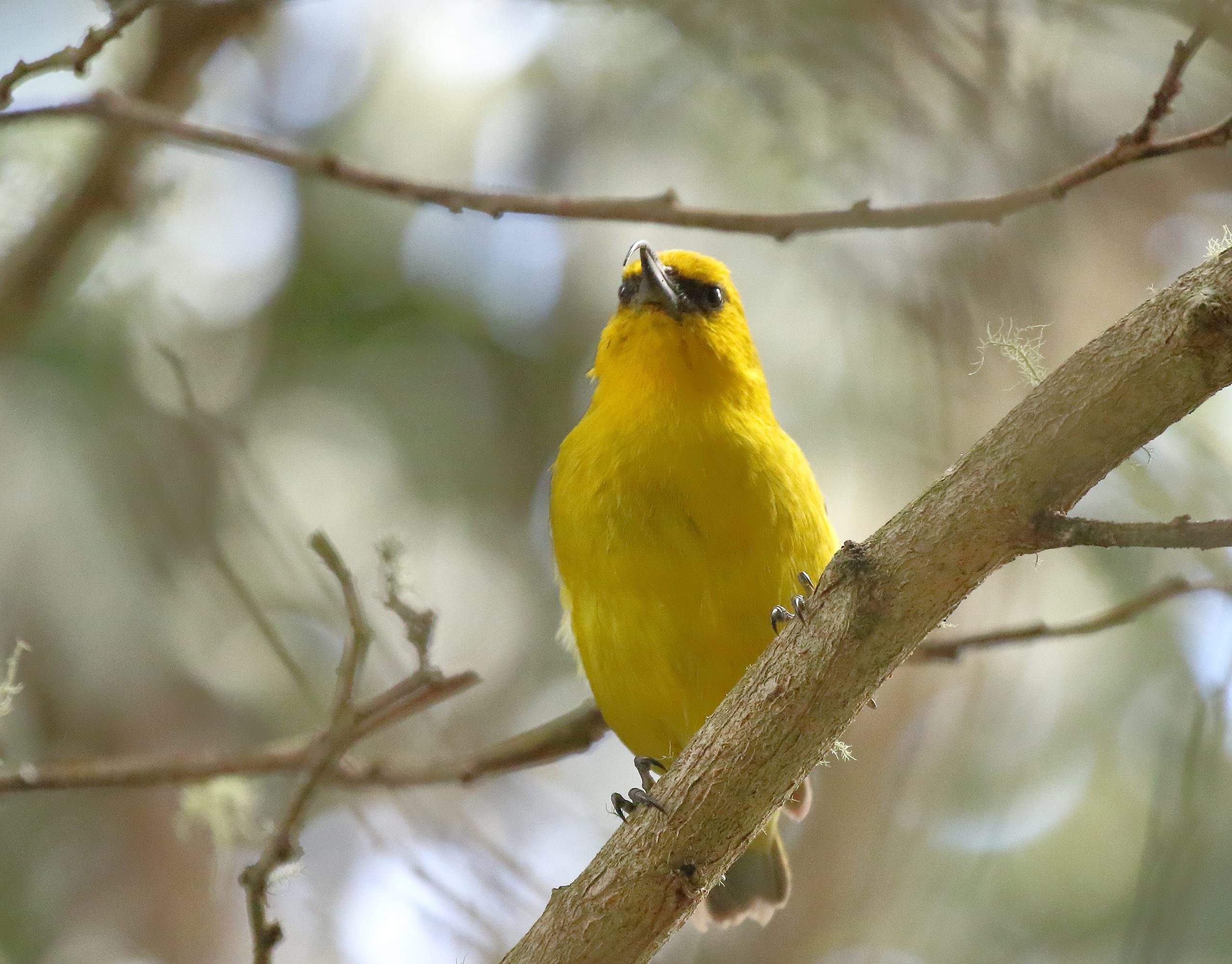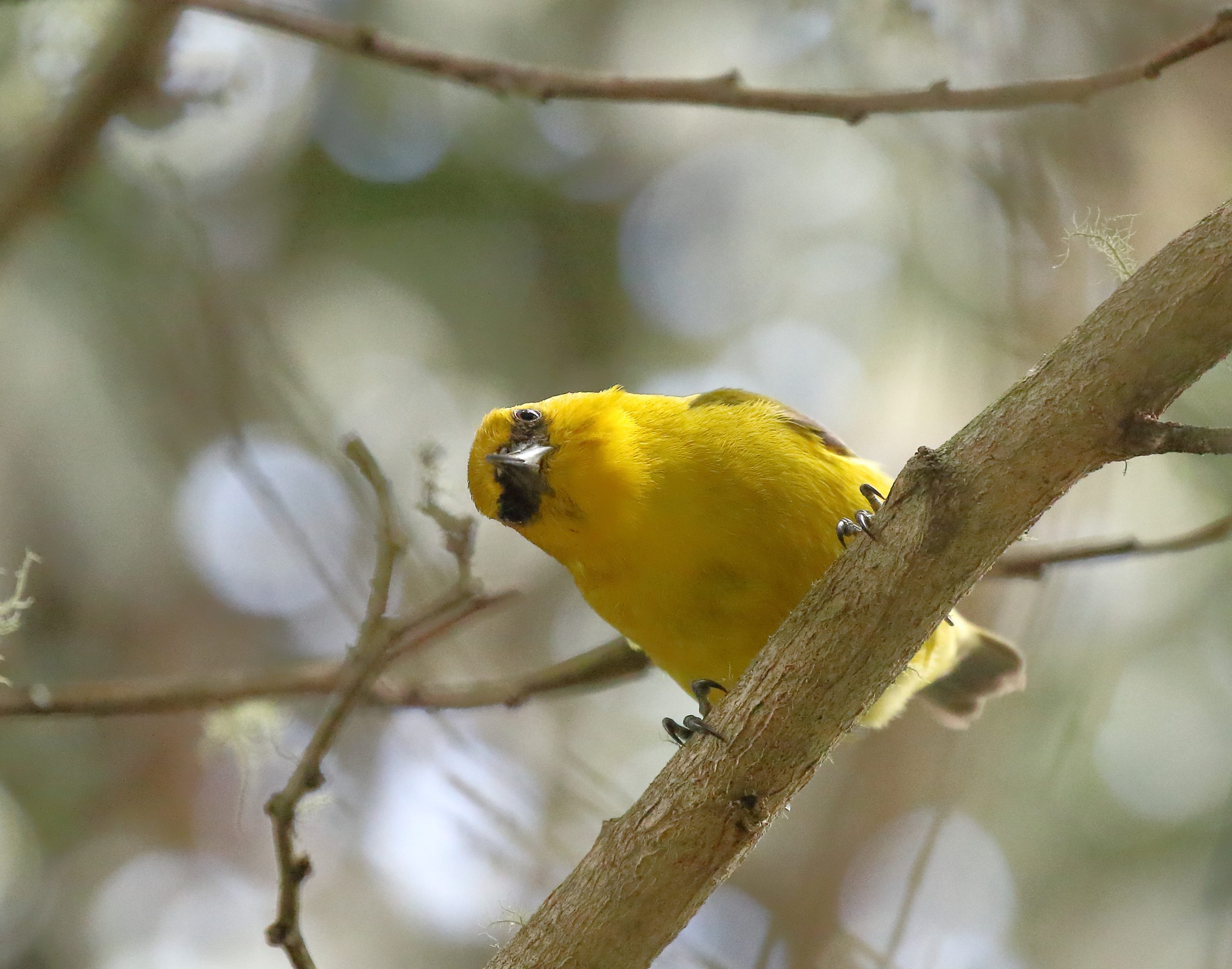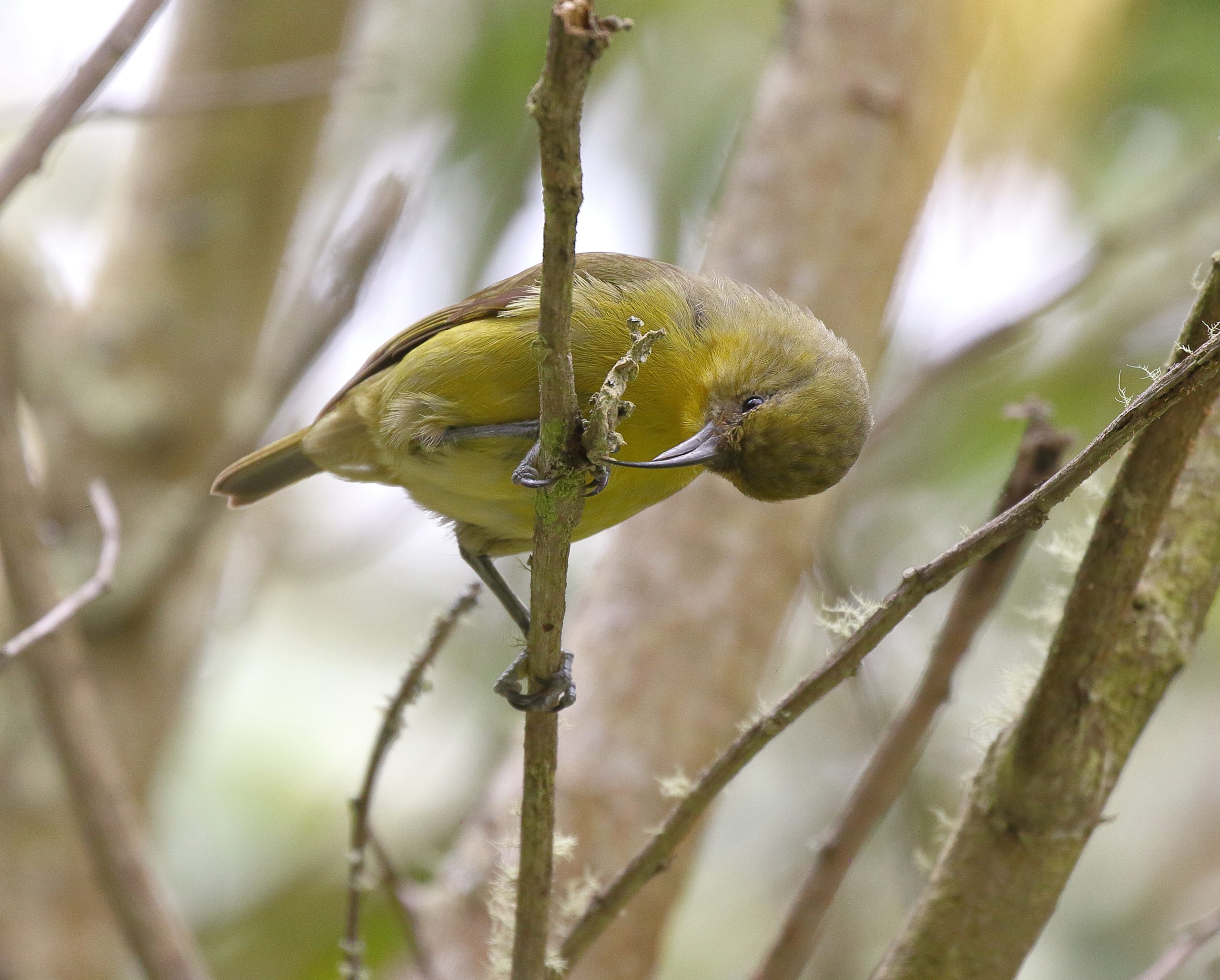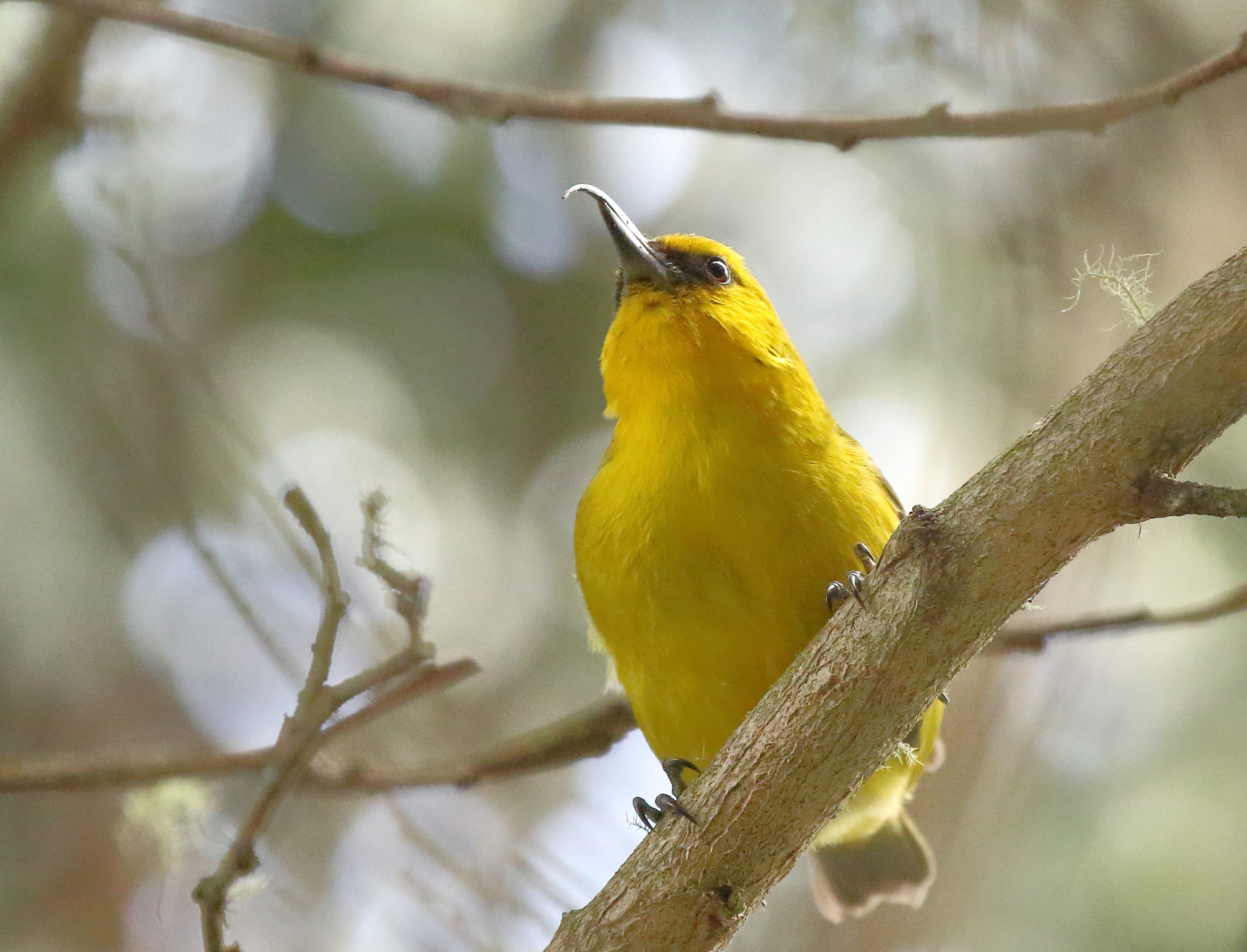ʻAkiapōlāʻau
Names
- Ōlelo Hawaiʻi: ‘Akiapōlā‘au
- Scientific: Hemignathus wilsoni, Hemignathus munroi
Song
Conservation Status
- Federally Listed as Endangered
- State Listed as Endangered
- State Recognized as Endemic
- NatureServe Heritage Rank G1—Critically Imperiled
- IUCN Red List Ranking—Endangered
- Revised Recovery Plan for Hawaiian Forest Birds—USFWS 2006
Species Information
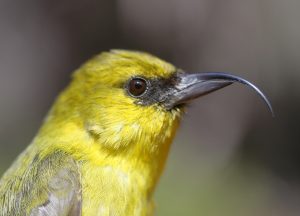
ʻAkiapōlāʻau. PC: Bret Mossman
The ‘akiapōlā‘au is a stocky Hawaiian honeycreeper (Family: Fringillidae) endemic to the island of Hawai‘i and most famous for their specialized bills, which have a long, decurved upper mandible and a short woodpecker-like lower mandible. Adult males have a bright yellow head and underparts, yellow-green back and wings, and a small, black mask. Adult females are olive above with grayish-yellow to yellow underparts. Males are larger than females and have longer bills. They often join hunting parties made up of several specie; which vary depending on habitat. ‘Akiapōlā‘au are mainly insectivorous, with Lepidoptera larva, spiders, and beetle larva being the most important prey items. It rarely takes nectar but takes sap from holes it excavates in ‘ōhi‘a (Metrosideros polymorpha) trees. Most frequently, creeps along lichen covered and dead branches of koa (Acacia koa), kōlea (Myrsine lessertiana), māmane (Sophora chrysophylla), and naio (Myoporum sandwicense) trees tapping branches with their lower mandible to locate prey. Once a food item is located, lower mandible is used similar to that of a woodpecker bill to chisel open a hole. The upper mandible is then used to fish out the prey item. Upper mandible also used to examine natural cracks and crevices. Breeding has been documented year-round, although most activity occurs from February to July. The species’ open cup nest is most often placed in ‘ōhi‘a trees. They usually lay one, rarely two, eggs and females perform all incubation and brooding. Males provide females and nestlings with the majority of food. Only one fledgling is produced per year, and a long period of parental dependency, usually four to five months, is typical. Family groups consisting of newly born and one year old chicks have been observed. This species is characterized by low annual productivity.
Distribution
Occurs in three disjunct populations between 1,500 and 2,000 meters (4,875–6,500 feet) elevation on the Island of Hawai‘i. Original range likely included all forested areas of the island.
Habitat
Occurs in mesic and wet montane forests dominated by koa and ‘ōhi‘a. The small and declining population on Mauna Kea occurred in subalpine dry forest dominated by māmane and naio. A recent study documented ‘akiapōlā‘au occurring entirely in areas reforested with koa (i.e., second-growth, young forests). Habitat quality varies across the species’ occupied range. Most remaining populations occur on lands managed by the State of Hawai‘i and the U.S. Fish and Wildlife Service.
Threats
‘Akiapōlā‘au are likely susceptible to the same factors that threaten other native Hawaiian forest birds, including habitat loss and degradation, predation by introduced mammals, and disease. For ‘akiapōlā‘au populations, the following are of particular concern:
- Low reproductive potential. Unlike many Hawaiian honeycreepers, ‘akiapōlā‘au have low annual fledgling production. This life history characteristic may be related to their very specialized foraging strategy. Regardless, the species is very susceptible to factors that reduce population size.
- Disease. Unlike several other honeycreepers found on the island of Hawai‘i (e.g., Hawai‘i amakihi [C. virens]), the ‘akiapōlā‘au is absent from most areas below 1,350 meters (4,500 feet). This suggests that the species is particularly susceptible to mosquitoborne avian disease.
- Predation. Although little evidence exists, predation by rats (Rattus spp.), cats (Felis silvestris), small Indian mongoose (Herpestes auropunctatus), and owls (Asio flammeus sandwichensis, Tyto alba) may limit ‘akiapōlā‘au populations. Recent surveys have determined that rat density in the Hakalau Forest National Wildlife Refuge, which supports a significant portion of the ‘akiapōlā‘au population, is high. In addition, the loud, persistent begging of juveniles may make them especially vulnerable to predators.
- Habitat degradation. Habitat loss and degradation from development, logging, and grazing has greatly fragmented the species’ habitat.
- Population size. Small populations are plagued by a variety of potentially irreversible problems that fall into three categories: demographic, stochastic, and genetic; the former are usually most problematic. Demographic factors include skewed sex ratios and stochastic factors include natural disasters. Habitat fragmentation exacerbates
demographic and genetic problems
Explore from Home
Plans & Projects
Additional Resources
For more information and references visit the State Wildlife Action Plan factsheets. DOFAWʻs species pages and State Wildlife Action Plan fact sheets are provided for general information and are not meant to be a citable, original source of data. If you are a student, researcher, or writer looking for a citable source, please explore the references below or find other original data sources, rather than citing these webpages. The references below were provided by the authors of the State Wildlife Action Plan fact sheets at the time of drafting:
- Gorreson, PM, Camp RJ, Reynolds MH, Woodworth BL, Pratt TK. 2009. Status and Trends of Native Hawaiian Songbirds. In Conservation Biology of Hawaiian Forest Birds (Pratt TK, Atkinson CT, Banko PC, Jacobi JD, Woodworth BL, editors). Yale University Press.
- IUCN Red List of Threatened Species. 2015. Version 2014.3. Available at: www.iucnredlist.org. (Accessed May 2015).
- Pejchar, L. 2005. Home range size varies with habitat type in a Hawaiian honeycreeper: implications for native Acacia koa forestry. Ecological Applications 15:1053-1061.
- Pratt TK, Fancy SG, Ralph CJ. 2001 ‘Akiapola‘au (Hemignathus munroi) and nukupu‘u (Hemignathus lucidus). In The Birds of North America, No. 600 (Poole A, Gill F, editors.). Philadelphia, (PA): The Academy of Natural Sciences; and Washington DC: The American Ornithologists’ Union.
- Strommer L. University of Hawai‘i graduate student. Unpublished data.
- U.S. Fish and Wildlife Service. 2006. Revised Recovery plan for Hawaiian forest birds. Portland, (OR): U.S. Fish and Wildlife Service.


